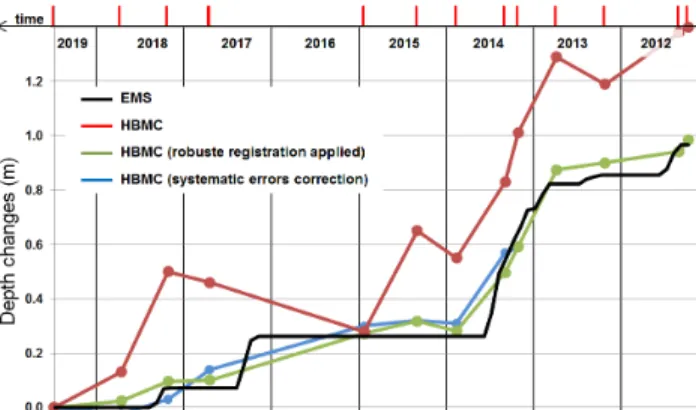HAL Id: hal-02508980
https://hal-ensta-bretagne.archives-ouvertes.fr/hal-02508980
Submitted on 16 Mar 2020
HAL is a multi-disciplinary open access
archive for the deposit and dissemination of
sci-entific research documents, whether they are
pub-lished or not. The documents may come from
teaching and research institutions in France or
abroad, or from public or private research centers.
L’archive ouverte pluridisciplinaire HAL, est
destinée au dépôt et à la diffusion de documents
scientifiques de niveau recherche, publiés ou non,
émanant des établissements d’enseignement et de
recherche français ou étrangers, des laboratoires
publics ou privés.
Systematic errors estimation in repeat MBES surveys
Nathalie Debese, Jean-José Jacq, Marc Roche, Rodéric Moitié, Koen
Degrendele
To cite this version:
Nathalie Debese, Jean-José Jacq, Marc Roche, Rodéric Moitié, Koen Degrendele. Systematic errors
estimation in repeat MBES surveys. Canadian Hydrographic Conference 2020, Feb 2020, Québec,
Canada. �hal-02508980�
Systematic errors estimation in repeat MBES surveys
Nathalie Debese
1, Jean José Jacq
2, Marc Roche
3, Rodéric Moitié
1, Koen Degrendele
31ENSTA Bretagne STIC/HOP, 2IMT-Atlantique, 3Federal Public Service Economy, SMEs, Self-employed and Energy –
Continental Shelf Service
1,2Brest France, 3Brussel Belgium
Nathalie.debese@ensta-bretagne.fr
Abstract— Repeated multibeam echosounder (MBES) surveys are carried out over dredging areas to control the sand extraction. This work aims at detecting and estimating systematic errors present in a bathymetric time series by performing a robust and global registration of their osculatory surfaces.
Keywords—MBES; Bathymetry; Bedforms; Trend surfaces; Registration; Systematic errors; Osculatory surfaces;
I. INTRODUCTION
The volume of sand extracted in the Belgian part of the North Sea is derived from Electronic Monitoring System (EMS) data. EMS are black-boxes installed aboard dredger ships recording both their position and pump activity. The environmental impact of sand extraction on the bathymetry is controlled by repeated MBES surveys of monitoring areas. Analysis of discrepancies between volumes estimated using EMS and MBES surveys highlights the presence of systematic errors in MBES datasets. In order to detect and quantify these systematic errors, a new robust and global approach was developed and successfully applied to a monitoring area.
II. DATASET DESCRIPTION AND METHODOLOGY
Our studied area (HBMC) is located in the S4c extraction sector of the Belgium continental shelf. This monitoring zone is a narrow strip of land that partially covers the Oosthinder bank, a tidal sandbank assumed to be stable. This reference area is surveyed since April 2012 up to July 2019 using the RV
Belgica SIMRAD EM3002D. Bathymetric data acquired
during these surveys were corrected using the same processing steps. The thirteen DBMs (Digital Bathymetric Model) available on HBMC show that a large part of the zone undergoes noticeable sand extraction or large dune migration. While the temporal evolution of the sand volume estimated from MBES data is mainly explained by the extraction, differences between EMS and MBES data exist and were investigated using osculatory surfaces [1]. Osculatory surfaces are trend surfaces extracted from DBM that split the sandbank into a stable part and dynamic part for a given time period. The detection and estimation of systematic errors rely on the robust and global registration of stable bedform features while taking into account the dredging impacts on the seabed morphology [2].
III. RESULTS AND CONCLUSIONS
Our approach was applied to the global registration of the thirteen osculatory surfaces on HBMC using the last survey as a reference. Indeed, this survey was reduced using GNSS derived tidal data and is therefore considered as more reliable. The temporal volume variations deduced from MBES bathymetric data after removal of these residual bias significantly improves the correlation with EMS data. Thanks to the GNSS tidal reduction applied to data of the last survey, we now have an estimation of systematic errors associated with each DBM. For each survey, a statistical analysis of heave, dynamic draft and tide gauge data was conducted that confirms the estimation deduced from the robust registration of osculatory surfaces time series.
These results show that, despite the difficulties inherent to HBMC dataset (sparse and irregular MBES surveys, dredging periods and hydrodynamic complexity) our approach is a promising tool that will help hydrographers to detect and estimate systematic errors present in bathymetric time series.
REFERENCES
[1]Nathalie Debese, Jean-José Jacq, Koen Degrendele, Marc Roche, Thierry Garlan. Osculatory Surfaces Extraction applied to Monitoring of Sub-marine Sand Materials. Marine Geodesy, Taylor & Francis, 2018, 41 (6), pp.605-631.
[2] Nathalie Debese, Jean-José Jacq, Koen Degrendele, Marc Roche. Osculatory surfaces applied to systematic errors estimation in repeated MBES surveys. In Proc. of Marine and River Dune Dynamics (MARID) VI, 267 pp., ISBN:978-2-11-139488-9, pp. 69-75, Apr 2019, Bremen, Germany.
Fig. 1. Variations in sediment volumes estimated from MBES and EMS data as a function of time. The time origin is the last survey.
